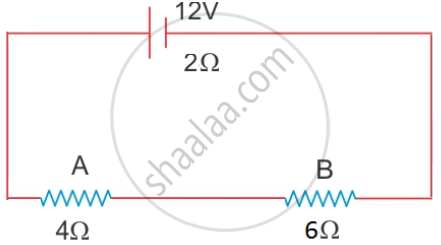Advertisements
Advertisements
प्रश्न
How much energy is transferred by a 12 V Power supply to each coulomb of charge which it moves around a circuit?
उत्तर
The term 'each coulomb' means 'every 1 coulomb'.
So, charge, Q = 1 C
Potential difference, V = 12 V
Now:
V = W/Q
12 = W/1
So, work done, W = 12 x 1 = 12 J
Since the work done on each coulomb of charge is 12 J, the energy transferred to each coulomb of charge is also 12 J.
APPEARS IN
संबंधित प्रश्न
A battery of emf 12 V and internal resistance 2 Ω is connected with two resistors A and B of resistance 4 Ω and 6 Ω respectively joined in series.

Find:
1) Current in the circuit
2) The terminal voltage of the cell
3) The potential difference across 6Ω Resistor
4) Electrical energy spent per minute in the 4Ω resistor.
What is the unit of electric charge?
How is a voltmeter connected in the circuit to measure the potential difference between two points? Explain with the help of a diagram.
Keeping the potential difference constant, the resistance of a circuit is doubled. The current will become:
100 joules of heat is produced per second in a 4 ohm resistor. What is the potential difference across the resistor?
A current of 1.6 mA flows through a conductor. If charge on an electron is –1.6 × 10-19 coulomb, find the number of electrons that will pass each second through the cross section of that conductor.
State whether the potential is a scalar or vector?
______ is work done per unit charge.
Study the following circuit and find:

- Effective resistance of the circuit
- Current drawn from the battery
- Potential difference across the 5 omega resistor
Find the potential difference required to flow a current of 300 mA in a wire of resistance 20 Ω.
